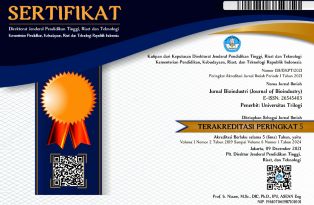PENGENDALIAN PENYAKIT LAYU BAKTERI (RALSTONIA SOLANACEARUM) PADA TANAMAN TOMAT DENGAN PENYAMBUNGAN BATANG BAWAH TAHAN
Abstract
Tomato plant is one of horticultural commodities that plays an important role in agricultural of Indonesia. The production of tomato is constrained by bacterial wilt (R. solanacearum). The development of the disease will increase rapidly in rainy season. This causes the production of tomato decreases for about 30-60%. The alternative effort to control the bacterial wilt (R. solanacearum) done by grafting the commercial tomato plants that are susceptible to noncommercial tomato that have natural resistance to the infection of this pathogen. Suseptible tomato Betavila F1 variety is used for scion. As resistant rootstocks are Rewako F1 and Mawar variety. The grafting done through splice grafting. The experimental design used was Complete Randomized Design with 5 treatments of 4 repetitions with each unit consisted of 5 plants. The observed parameters were incubation period, incidence of disease, severity of disease, infection rate and plant growt. The results of observation data were analyzed by using variance. The grafting treatment between Rewako F1 + Betavia F1 varieties became the best result to inhibit the bacterial wilt of R. solanacearum incubation period 14 Day After Inculation (DAI), incidence of disease 28,00%, infection rate 0,00500 unit/day and necrosis in stem 5,50%. The grafting treatment was not able to increase the component of plant growth.
Keywords: Grafting, Tomato, Bacterial wilt disease
Keywords
Grafting, Tomato, Bacterial wilt disease
Full Text:
PDFDOI: https://doi.org/10.31326/jbio.v2i1.480
DOI (PDF): https://doi.org/10.31326/jbio.v2i1.480.g290
Refbacks
- There are currently no refbacks.
Editorial Office:
Fakultas Bioindustri
Universitas Trilogi
Jl. TMP Kalibata No.1
Jakarta 12760
Copyright Notice:


2.png)






2.png)







